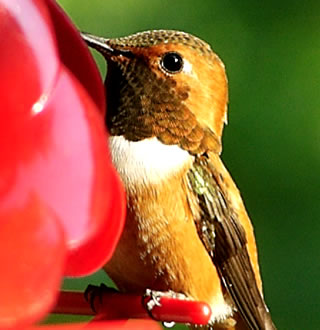| Perennials |
Perennials |
Annuals |
Bulbs |
Vines |
Shrubs Trees |
Bee balm
Monarda didyma |
Butterfly weed
Ascelpias tuberosa |
Mountain garland
Clarkia elegans |
Tuberous Begonia
Begonia |
Bougainvillea
Bougainvillea |
Abelia
Abelia grandiflora |
| Tuberous Begonias |
|
Begonias need bright, filtered light, with maximum light in winter. Allow
the soil to only dry slightly between waterings. Provide additional humidity |
| Columbine |
Aquilegia |
12-18" |
Columbines are a favorite flower for hummingbirds, and are excellent additions to rock gardens or in a native woodland planting |
3-9 |
    |
| Cardinal flowerLobelia cardinalis |
Columbine
Aquilegia |
Four-o'-clock
Mirabilis jalapa |
Canna
Canna |
Cardinal climber
Ipomoea quamoclit |
Azalea
Rhododendron |
| Azalea |
Rhododendron |
Azaleas must be grown in an acid soil, with a pH of 5.0 to 6.5. They will not tolerate lime. |
| Morning Glories |
Ipomoea |
Fast growing annual vine, readily reseed themselves for the next year. |
| Coral Bells |
Heuchera sanguinea |
12-18" |
Glossy, 3 inch, deeply lobed green to purple leaves; clusters of scarlet flowers on a stout 15" red stems in early-mid Spring |
6-9 |
   |
Coral bells
Heuchera sanguinea |
Cosmos
Cosmos |
Touch-me-not
Impatiens |
Gladiola
Gladiolus |
Flame vine
Pyrostegia venusta |
Bottlebrush
Callistemon lanceolatus |
| Cosmos |
Cosmos bipinnatus |
Cosmos are extremely heat and drought tolerant.They like full sun and do well in poor, unfertile soil |
| Chocolate Cosmos |
Cosmos atrosanguineus |
The dark maroon flowers appear on wirey 18 inch stems from June until frost and produce a pleasant chocolate scent |
Dahlia
Dahlia |
Delphinium
Delphinium elatum |
Flowering tobacco
Nicotiana alata |
Iris
Iris |
Honeysuckle
Lonicera |
Butterfly bush
Buddleia davidii |
| Butterfly bush |
Buddleia davidii |
The Butterfly Bush will grow up to 15' tall in almost any type of soil. Plant in full sun or light shade. |
| Trumpet Honeysuckle |
Lonicera sempervirens |
May need support when first starting out, profuse evergreen bloomers. Great for hummingbirds. |
| " title="Photograph of a Goldflame Honeysuckle">Goldflame Honeysuckle |
Lonicera heckrottii |
|
| Dahlias |
Dahlia |
Dahlia plants range in height from as low as 12 inches to as tall as 6-8 feet. The flowers can be as small as 2 inches or up to a foot in diameter. |
| Bears Breeches |
Acanthus spinosus |
4 ft. |
Large spined leaves |
7-10 |
   |
Flame acanthus
Acanthus mollis |
Foxglove
Digitalis purpurea (Biennial) |
Nasturtium
Tropaeolum majus |
Montbretia
Crocosmia |
Lantana
Lantana |
Catoneaster
Catoneaster |
| Foxgloves |
Digitalis purpurea |
3-6 ft. |
Foxgloves prefer moist, well draining, fertile soil but can survive drought and almost any growing conditions. |
4-9 |
    |
| Fuchsia |
Fuchsia |
1-4 ft. |
Fuchsia care is often determined by where you live and your climate. Fuchsias can be seed grown or struck from softwood cuttings |
7 |
    |
Fuchsia
Fuchsia tricolor |
Geranium
Pelargonium |
Petunia
Petunia hybrida |
|
Rosary vine
Ceropegia woodii |
Eucalyptus
Eucalyptus |
Hollyhock
Althea rosea (biennial) |
Lupine
Lupinus hybrids |
Spider flower
Cleome hasslerana |
|
Trumpet creeper
Campis grandiflora |
Flowering currant
Ribes odoratum |
| Red Flowering Currant |
Ribes sanguineum |
Flowering Currants produces clusters of red flowers which attract hummingbirds, butterflies and bees, and berries to be eaten by birds. |
Monkeyflower
|
Penstemon
Penstemon |
Zinnia
Zinnia |
|
Trumpet Vine
Bignonia tagliabuana |
Flowering Quince
Chaenomeles |
| Creeping Zinnia |
Sanvitalia procumbens |
Creeping Zinnia is a bright little yellow flowering annual plant. They should be planted in rich, well draining soil, in full sun. |
| Beard
Tongue |
Penstemon Barbatus |
12-24" |
Tubular flowers in red, pink, purple, or white will be sure to attract butterflies and hummingbirds to your garden. |
4-9 |
   |
| Pineleaf Penstemon |
Penstemon pinifolius |
10-18" |
Dark orange flowers, needle-like foliage; blooms June to September |
7 |
   |
Red hot poker
Kniphofia uvaria |
Sage
Salvia officinalis |
|
|
|
Fuchsia tree
Fuchsia arborescens |
| Perennial Sage |
Salvia nemorosa |
3 ft. |
Narrow erect plant with irregular leaves, spikes of small purple to white blooms in the Summer |
5-10 |
    |
| Speedwell |
Veronica prostrata |
8"-12" |
Forms mat of woody stems and saw-toothed leaves; spikes of small blue flowers in early Summer, Hummingbird flower |
5-9 |
  |
Scarlet sage
Salvia splendens |
Speedwell
Veronica hybrids |
|
|
|
Hibiscus
Hibiscus |
Verbena
Verbena |
|
|
|
|
Lilac
Syringa |
| Lilacs |
Syringa vulgaris |
5-8 ft. |
Lilacs require full sun for maximum bloom. They prefer a slightly alkaline soil (pH 7.5). |
3-7 |
   |
| |
|
|
|
|
Mimosa (silk tree)
Albizia julibrissin |
| |
|
|
|
|
Strawberry tree
Arbutus unedo |
| |
|
|
|
|
Wild lilac
Ceanothus griseus |
| |
|
|
|
|
Weigela
Weigela rosea |
